Activities are part of our nursery's afternoon program, though which we want to give children the opportunity to get to know and try all kinds of "art", to develop various skills and primarily to discover their own interests and talents.
If interest allows, the afternoon activities for the children from our nursery will also be followed by activities for the general public, open to children of the same age or older, parents with children or only parents, who will be able to leave their children in the playroom for the duration of the activity.
Cooking and handiwork or "How things are made"
Where do lollipops grow before they get to the store? And how does a tree become a chair? Children want to know where things come from. According to a Confucian proverb, “Tell me and I will forget, show me and I will remember, involve me and I will understand,” knowing means trying, experiencing. Thus the “How things are made” activity is not only about “cooking and sewing” but primarily about the process of creation of anything from the beginning to the end, about getting to know the sources, materials and tools and subsequently about the development of the ability to use them skilfully and creatively. We prepare a vegetable patch, sow seeds, take care of what grows, harvest it, cook it and ultimately eat it. In the forest we gather products of nature, observe them, examine them, do experiments, try to see what all can be made from them. We start by observing the items around us and at the end there may be a baked pie or a bird feeder that the children sawed and pounded nails into by themselves. What we are striving for is for children to not be lost among adult items and tools, for them to not always look for everything in shops, for them to be independent in all kinds of practical activities, to know how to work with their hands and to be able to creatively use the items around us and to make new things out of them. The activity is lead by Pavla Hrušková.
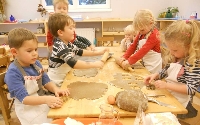
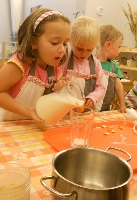
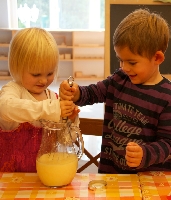
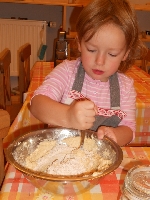
Music and Creative Recorders
Music is humanity’s universal language. We don’t need to learn its language; it is the same for us all. It awakens joy and happiness in us or peace and contemplation; it teaches us to perceive our inner world and to listen to what it tells us. In our afternoon games with music we are introduced to the noises around us and the sounds of various instruments, we learn to awaken musical feelings and rhythm inside ourselves and to differentiate musical moods. We sing Czech and English songs, we play on various instruments (Orff instruments, piano, guitar, recorder), we listen to classical and ethnic music. Talent is not important, but rather the joy from making music together. The development of rhythmic and intonation skills opens up new opportunities for us in our day-to-day lives and joy from spontaneous expression. Markéta Vrbinčíková leads the activity. More here.
Arts
Similarly to “How things are made,” Arts and crafts activity, which alternates with ceramics, is primarily about getting to know materials and techniques, about examining the possibilities of working with them and developing fine motoric behaviour, but also about awakening free creativity. Our goal is for children to be able to handle various materials and techniques so that they are not afraid to pick up any substance or tool and can let loose their own imaginations and decide for themselves about what to do with a pile of clay, stones and pinecones, with pieces of cloth, coloured thread and buttons or with blank paper, paints and brushes or scissors and glue. The activity is lead by Veronika Lněníčková, the teacher of the Primary class. More here.
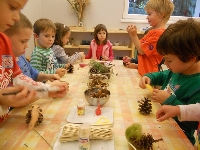
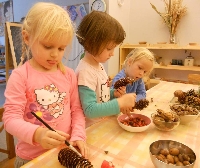
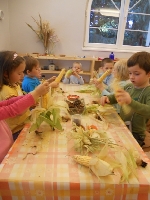
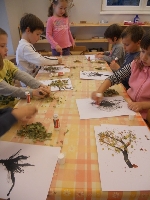
Yoga
Through playful and creative yoga exercises children can get to know their bodies, their capabilities, reactions and needs. They perceive their feelings combined with movement. They learn how they themselves can eliminate tension and stress. Using stories, poems or songs we get to know the traditional positions, for which the children think up new names, we imitate animals, trees, items and together we create our own positions. We try various forms of breathing and learn relaxation, which leads to loosening up and strengthening our mental balance. We then talk about our feelings or we give them form on paper as a picture that reminds us what we practiced and experienced. Daniela Fremuntová leads the activity. More here.
Kathak dance
What mood does music arouse in us? What story can it tell us? And what story can we tell through movement, how a word, an idea, an experience can inspire us. During dance gatherings we develop sensitivity to our own bodies, to the space around us, to the other people around us. Through dance we discover rhytm in our own bodies. We perceive the diverse atmosphere of music, we learn how to identify with it and to get our bodies and minds moving, depicting our own moods, feelings and ideas through movement… Our perception of music and dance and our enthusiasm for passing it to children have not changed, we have only moved more to the East since children really loved the kathak workshop we held last year, and therefore we wanted to give them more. Kathak is a classical dance of nothern India with specific and very attractive techniques, containing rhythmic stomping, spinning, graceful hand movements, and also playing with animals, natural elements and symbols of life. The classes are conducted by an experienced dance teacher Ivana Hessova. More here.
Handykids
Children long to do and learn everything they see us adults doing. In Wednesday’s wonderful workshop they have the opportunity to try out everything they are usually not allowed to do – hammering, drilling, sawing, plastering, painting, sharpening, pasting, cutting, bending and a lot of other interesting work "../for grownups." They make real things with real tools. And they also learn to always clean up after working. David Lněníček leads the activity.
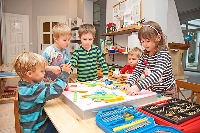
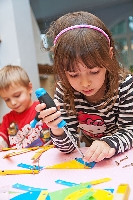
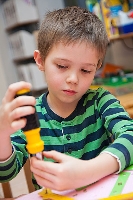
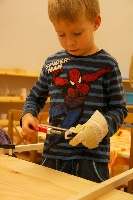
Aikido
We chose the Aikido activity for children from 3 and up for Willowtrees because we have this Japanese art of self-defence in the family and thanks to their grandfather our children were introduced to it when in their diapers. Of course it is not aikido like adults or other children practice it, but more of a universal movement conditioning, the goal of which is the overall development of movement abilities and the coordination of movement. The training includes breathing exercises, stretching and strengthening all parts of the body, various forms of games and exercises focussed on improving mental concentration and head-arm, head-fingers and head-leg coordination as well as training simple falls. Fast activities alternate with slow ones, movement with rest, silence with yells. The children let off some steam and meanwhile they improve their movement skills as well as the ability to calm down and concentrate. The aikido activity is mainly about the children getting to know their bodies and their bodies' possibilities and to develop them. Of course they also receive the basics for any eventual continuation in some of the modern self-defence martial arts or sports (such as judo or karate in addition to aikido). The activity is lead by Miroslav Kodym. More here.
Preparation for School
What all changes for our preschoolers during the transition to elementary school? They definitely can expect greater responsibility and more obligations and, for some, probably less of an opportunity to choose, more head-on instruction, tests and exams, evaluations. Our goal is to prepare preschoolers for these changes during the school year. We guide children to accept responsibility for their learning - to systematic work, planning, self-evaluation. We work with Montessori aids from all areas, which help the children to develop practical skills, mathematical thinking and the knowledge of the world around them in context and to get them ready for writing and reading. Our preparation for school also includes the Maxík program (a program for preschoolers accredited by the Ministry of Education, Youth and Sports, see web for more information), oriented on the development of graphomotor, visual motor, audio-motor and communication skills. The activity is led by Veronika Lněníčková. More here.



